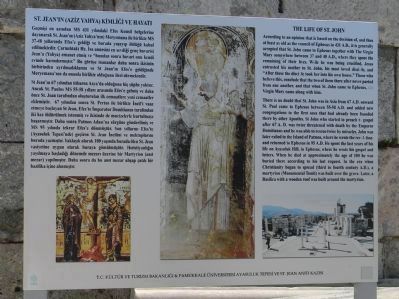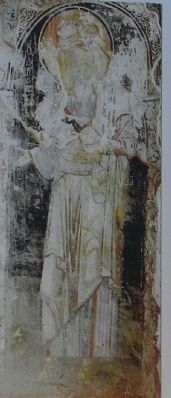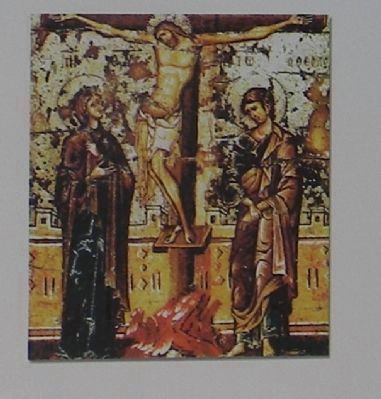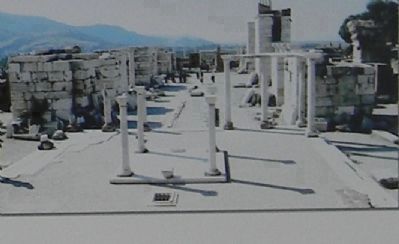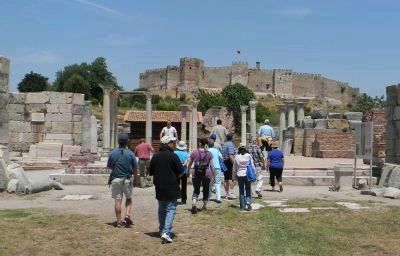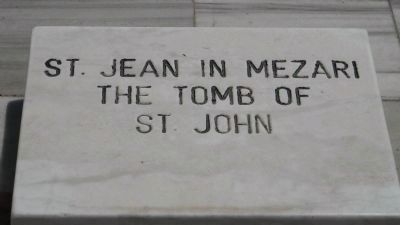İsa Bey in Selçuk, İzmir, Turkey — West Asia or Southeast Europe
St. Jean'in (Aziz Yahya) Kimliği Ve Hayatı/The Life of St. John
[Left column: text in Turkish]
[Right column: text in English]
According to an opinion that is based on the decision of, and thus at least as old as the council of Ephesus in 431 A.D., it is generally accepted that St. John came to Ephesus together with The Virgin Mary somewhere between 37 and 48 A.D., where they spent the remaining [days] of their lives. While he was being crucified, Jesus entrusted his mother to St. John, his most loved disciple, and After these the disciple took her into his own house. Those who believe this, conclude that the two of them there after never parted from one another, and that when St. John came to Ephesus, the Virgin Mary came along with him.
There is no doubt that St. John was in Asia from 67 A.D. onward. St. Paul came to Ephesus between 5558 A.D. and added new congregations to the first ones that had already been founded there by other Apostles. St. John who started to preach the gospel after 67 A.D was twice threatened with death by the Emperor Domitianus and he was able to rescue twice by miracles. John was later exiled to the Island of Patmos, where he wrote the revelation and returned to Ephesus in 95 A.D. He spent the last years of his life on Ayasuluk Hill, in Ephesus, where he wrote his gospel and letters. When he died at approximately the age of 100 he was buried there according to his last request. In the era when Christianity began to spread (third to fourth century A.D.), a martyrion (Monumental Tomb) was built over the grave. Later, a Basilica with a wooden roof was built around the martyrion.
Erected by T.C. Kültür Ve Turizm Bakanliği & Pamukkale Üniversitesi Ayasuluk Tepesi Ve St. Jean Aniti Kazisi.
Topics. This historical marker is listed in these topic lists: Cemeteries & Burial Sites • Churches & Religion.
Location. 37° 57.148′ N, 27° 22.077′ E. Marker is in Selçuk, İzmir. It is in İsa Bey. Marker can be reached from St. Jean Caddisi west of 2013 Sokak. Marker is inside the Basilica of St. John complex, mounted on the stone deck in the ruins off the south apse. Touch for map. Marker is in this post office area: Selçuk, İzmir 35920, Turkey. Touch for directions.
Other nearby markers. At least 8 other markers are within 3 kilometers of this marker, measured as the crow flies. St. Jean (Aziz Yahya) Kilisesi / The Church of St. John (a few steps from this marker); The Basilica of St. John (within shouting distance of this marker); Hellenistic Fountain House (approx. 2.6 kilometers away); The Great Theatre
(approx. 2.6 kilometers away); Ancient Ephesos (approx. 2.7 kilometers away); Byzantine Ephesos (approx. 2.7 kilometers away); Roman Ephesos (approx. 2.7 kilometers away); The Hellenistic Ephesos (approx. 2.7 kilometers away). Touch for a list and map of all markers in Selçuk.
Related markers. Click here for a list of markers that are related to this marker. To better understand the relationship, study each marker in the order shown.
Also see . . . John the Apostle. Wikipedia (Submitted on June 26, 2011, by Richard E. Miller of Oxon Hill, Maryland.)
Credits. This page was last revised on February 13, 2023. It was originally submitted on June 24, 2011, by Richard E. Miller of Oxon Hill, Maryland. This page has been viewed 944 times since then and 15 times this year. Photos: 1, 2, 3, 4, 5. submitted on June 24, 2011, by Richard E. Miller of Oxon Hill, Maryland. 6. submitted on June 25, 2011, by Richard E. Miller of Oxon Hill, Maryland. • Bernard Fisher was the editor who published this page.
